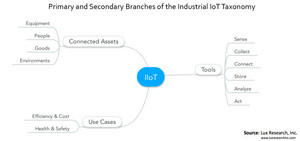BOSTON, MA--(Marketwired - Mar 8, 2016) - Cost, efficiency and safety are driving the much-hyped Industrial Internet of Things (IIoT) as companies worldwide in a wide range of industries look for opportunities to connect nearly everything in the industrial workplace, according to Lux Research.
"In cases ranging from wearables to real-time location systems in large yards, vendors like Equivital and PINC Solutions are establishing a clear value proposition in the quest to find viable business cases," said Isaac Brown, Lux Research Analyst and lead author of the report titled, "Defining the Industrial Internet of Things."
"Goals range from employee safety to simple efficiency improvements in asset management -- but users need to remain cautious about practical obstacles to proving this value in real operations," he added.
According to the taxonomy developed by Lux Research, connected assets fall into four distinct categories: equipment, people, goods, and environments. The IIoT systems that connected them have six discrete components, following the signal path from the sensors that measure the world around us through the actions taken by operators.
Lux Research analysts identified several case studies that demonstrate distinct value propositions. Among the highlights:
- Daimler ups operational efficiency. Using PINC Solutions' RFID-based systems, Daimler achieved 99% trailer yard accuracy and 50% reduction in trailer move time in its 1.3 million square foot plant in Saltillo.
- Equivital raises safety. Equivital demonstrated employee health and safety with a deployment of its IIoT systems at a chemical plant. At the heart of its EQ-02 LifeMonitor is a wearable that workers carry around their chests, which it reports has led to a significant reduction in rate of injury at this plant.
- Sight Machine brings optimization. By collecting and analyzing real-time data at multiple factories, Sight Machine helped an apparel manufacturer identify underperforming factories, optimize processes, and recommend a more effective preventive maintenance schedule.
The report, titled "Defining the Industrial Internet of Things," is part of the Lux Research Industrial Internet of Things Intelligence service.
About Lux Research
Lux Research provides strategic advice and ongoing intelligence for emerging technologies. Leaders in business, finance and government rely on us to help them make informed strategic decisions. Through our unique research approach focused on primary research and our extensive global network, we deliver insight, connections and competitive advantage to our clients. Visit www.luxresearchinc.com for more information.
Contact Information:
Contact:
Carole Jacques
Lux Research, Inc.
617-502-5314
carole.jacques@luxresearchinc.com
